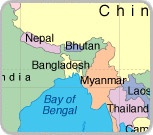Literacy for Livelihoods
|
>> ICT Literacy for Livelihoods
Much of Amader Gram field based activities are livelihood related. Normally livelihood refers to means of living, especially income generating activities, but in the context of development the meaning of this term is broader; Livelihood, therefore covers poverty reduction in a wider sense that includes such things as access of individuals or communities to resources which can help them to improve their quality of life, increase autonomy and decision making power, gender relations, and to access resources. The livelihood approach lays emphasis on sustainable and holistic activities that are flexible and compatible enough with local contexts.
Livelihood assets include human capital, natural capital, financial capital social capital, and physical capital. These assets, if developed in a sustainable way, can help raise the income level of society or the country, improve well being, utilize natural literacy resources properly, and reduce violence. We believe that to run activities in an effective and sustainable way, these activities should be holistic, flexible and compatible with local preference.
Purpose:
The purpose of considering livelihoods in ICT education projects is to enhance literacy practices, communication and access to information among men and women in local communities. Mainly-
• To work with local community to support programs designed to improve literacy, communication and access to information based on their different needs and aspirations.
• To help women and men in developing the different uses of reading, writing and numeracy that they need in their daily life.
• To enable national literacy agencies and NGOs to learn from our experience and to assist them in developing activities that 'bridge the gap' between the classroom learning and its wider social context.

